The original Section 8 was released to little fanfare back in late 2009. Despite some broadly positive reviews the game didn’t last long; it suffered from being a full-price title with no dedicated single-player mode trying to push its way into a glutted multiplayer marketplace (Battlefield 1943, Borderlands, Modern Warfare 2, Halo 3 ODST, Left 4 Dead 2, Op. Flashpoint: Dragon Rising and Wolfenstein are among some of the titles released roughly around the same time). It disappeared into the ether of rapidly cut-price titles, a few dedicated fans sticking with it but otherwise destined to be forgotten.
Section 8: Prejudice is a determined attempt to right the wrongs of its predecessor: it’s a budget release at £10 or 1200 MSP respectively (also coming to the PSN network later this year… possibly), it includes a variety of game modes and promises more as a reward for growing worldwide kill counts, and it includes a proper single-player campaign that gently introduces players to the game’s mechanics and fiction.
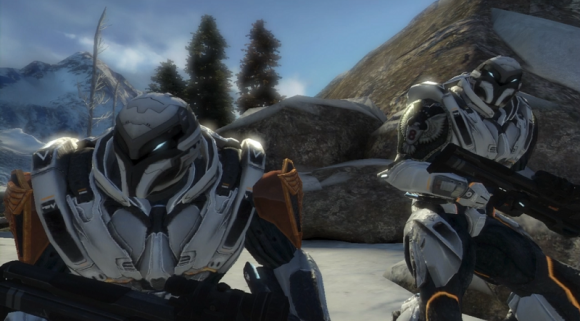
Said campaign is not particularly impressive; you’ve seen everything present before, the characters are without exception hard-bitten gruff stereotypes with minimal or no backstory, and the plot is a vague tale of interstellar factional war between some rebels, some military police, and some other dudes. That said it’s fun enough, with Normal mode surprisingly well-balanced between challenge and progression. On Hard you’ll find it a much tougher proposition with a lot of tough, bullet-spongey enemies flung at you. You’ll need to use your mobility to your full advantage to beat some of the game’s challenges. You will learn to despise the Engineer class.
Oh, and there’s a goddamn escort mission. Will no one ever learn? On Hard mode it’s a controller-chewing bloody nightmare, with the idiot tank you’re protecting trundling blithely into the centre of a firefight. It’s beatable but it ruins the game’s sense of tactical flexibility – to keep that tank alive you need to target and aggro just the right enemies in just the right order. Elsewhere there is an irritating platformy moment where I became stuck for some time, being repeatedly dropped into lava; a problem that also highlighted some occasionally thoughtless checkpointing. That aside, though, it was entertaining enough to climb a few rungs above ‘pleasantly diverting’.
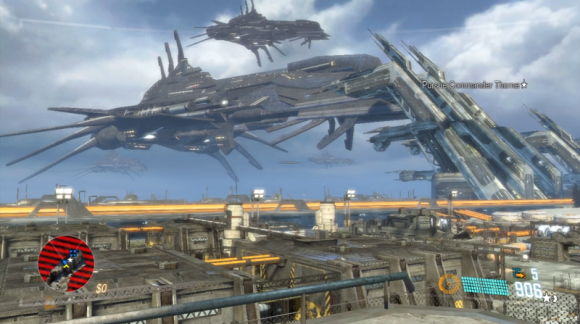
Prejudice is all about its juicy multiplayer offerings, however. At launch it included two such modes: Swarm and Conquest, with a third variant added (Assault) too late for this review. Swarm is akin to Gears of War’s Horde mode, with four human/AI players fending off increasingly tough waves of opponents. These levels can be very tough to beat, but the sense of accomplishment when you manage it is a fine reward. Best played with friends!
Conquest is more akin to traditional Team Deathmatch, but to describe it as such is to do it a disservice. Each map features between two and four bases; capturing the control point at their centre sets the base’s defences to friendly, providing an excellent stronghold. Controlling such bases also contributes points toward your team total. There are also plenty of other ways to gain points: killing enemies, repairing friendly units, utilising deployables, and the Dynamic Combat Missions.
DCMs occur constantly and randomly throughout Conquest games. Most involve collecting scattered objects, assaulting enemy outposts, escorting a friendly VIP or convoy and so on. In practice they add an element of unpredictability to the game: you never know what to expect when approaching them. Has the enemy army rallied around their DCM outpost, or have they left it defenceless? Can I collect that chunk of wreckage, or is there a sniper waiting for someone to try just that? If they’re concentrated here, is it a good opportunity to blitz their base and take the control point? The DCMs help keep battle fluid and prevent the game from turning into a slogging match over the bases.
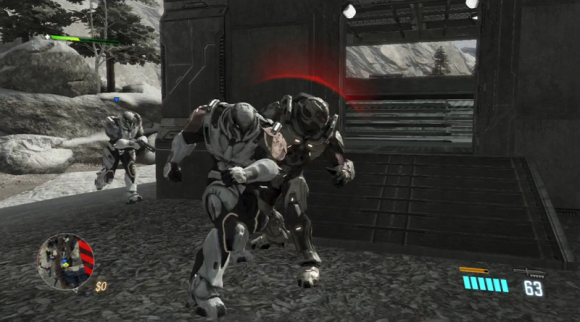
Adding to the fluid and unpredictable battles are the deployables. Players earn money in a similar way to gaining team points, and this can be spent within each match on a variety of turrets (anti-infantry, anti-vehicle, anti-air), support units (radar and supply depot) or vehicles (hoverbikes, mechs, tanks). If you’re determined to defend a friendly base or DCM objective, slam down turrets and support units, but if you want to assault the enemy then get yourself a vehicle – tanks can bombard defences, hoverbikes can harass outliers, and mechs can stride deep into enemy bases to take the fight to the defenders.
The game also has a plentiful macro unlock system, where achievements and experience points unlock new weapon options and armour upgrades. You can customise a variety of loadouts to suit your various playstyles – with the side effect that you can never exactly predict just how capable in certain areas an enemy might be. Forums are abuzz with requests for and condemnations of nerfs and balance issues, but when were they not? I’ve rarely felt cheated within the game.
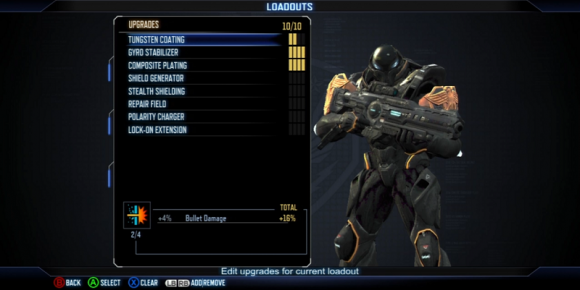
I mentioned mobility and agility earlier. There are a few ways that players can get about the medium-sized maps. First and most excitingly, deploying to the battlefield occurs from the air. Yep, you get dropped in from thousands of meters up, with a view of the entire map rapidly shrinking to the specific area you’re deploying to. You can manoeuvre a little on the way down, which is handy if you misjudged the range to an enemy AA gun or want to try and land on a rival’s head (a recommended act due to the associated deep sense of triumph). Secondly, and almost as good, is the jetpack. You’ll burn through the limited fuel for this quickly but it recharges soon enough; you can’t stay perpetually airborne but you can hop out of danger or surprise a sluggish enemy. You can also bump your regular sprint into Overdrive mode, moving at very high speeds.
Of course there are countermeasures to all of these mobility aids: a savvy enemy conquest team will drop AA guns everywhere, corralling enemy dropship reinforcements toward set areas. The game features a slow-recharging lock-on system which lets players glue their target reticule to an enemy player – no matter how high or fast they go. It only lasts a few moments but it can be enough to stop a wounded target escaping.
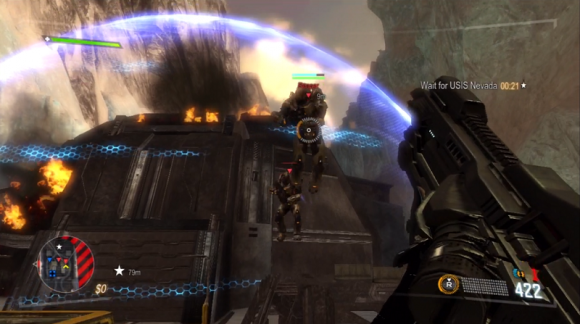
The core mechanics of S8P are solid enough to provide a good foundation for a shooter. That in itself is unexceptional, but the goodies built on those foundations – a fun and challenging co-op mode and a highly varied, entertaining and tactical competitive mode – are enough to elevate it to a highly recommended purchase, especially at its budget price-point. Plus, for all my criticisms of the campaign, I just completed my second playthrough: it’s hangover gaming gold.
I persevered with the single player of Section 8: Prejudice for the sake of getting some decent screenshots. I have to say that the the level of production on display is impressive considering that the game’s peers are Breach and Blacklight: Tango Down but it’s still not going to trouble the good single player FPS games out there.
Make no mistake, though, Section 8: Prejudice hits the ground running (at very high speeds) when it gets into the multiplayer portions. They have catered for both new and veteran FPS players, managing to keep things fast paced on large maps and eliminate campers as well as encourage players to diversify their play style.
This is down to the way that the game allows you to level your character (the options feel exhaustive); the amount of optional customisation in your layout is ridiculous, with all of your weapons swappable for any others and even the type of ammunition heavily customisable, plus you can even give your character different types of buffs across an array of qualities (be it extra armour, faster regenerating shields or quicker reloads).
Section 8: Prejudice is a gem and there is clearly love in there, from a dedicated website that tracks stats to the developers promising to unlock a new game mode for free once 10 million kills had been achieved (it happened and we have a new mode).
The most important part? Anyone can jump into a game and expect to kill other players with the basic loadout of any class. To achieve that depth and balance takes something divine.
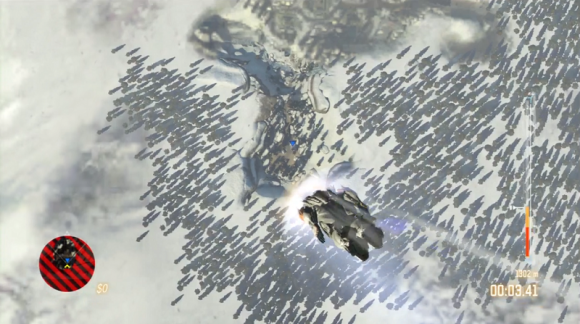
[Thanks to AJ for the sweet screenshots!]
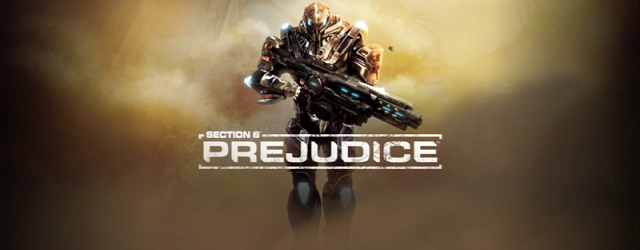

Comments
2 responses to “Section 8: Prejudice: Review”
I didn't really like this game very much. I wasn't comfortable with the controls – they felt a bit graceless, like my view was swinging wildly out of control and then coming to a sudden stop, the worst of both worlds. Never really found my feet with that element of it. The MP games were fun for a while and I can definitely see the depth and potential fun in them, but I found myself bored fairly quickly with not much motivation to dive back in.
Regret spending the points on it :(
Huh, didn't notice any of those problems, but then I don't play shooters as much as you do so I don't really require teh same finesse you do.
Shame you regret it, it sounds to me like you would have been better off writing the second opinion